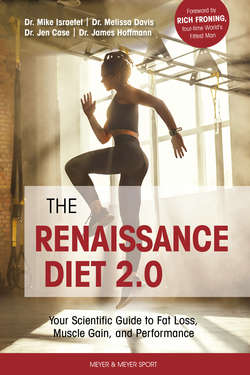Читать книгу The Renaissance Diet 2.0 - Mike Israetel, James Hoffmann - Страница 92
На сайте Литреса книга снята с продажи.
Carbohydrate Source Digestion Time and the Glycemic Index
ОглавлениеThe glycemic index measures how quickly a source of carbohydrate is digested and absorbed into the bloodstream. Glycemic indices can be determined in a lab setting by measuring the blood sugar concentrations of study participants over hours after having consumed a particular carb source; values are ranked on a scale of 0 (lowest) to 100 (highest). Quickly digested carbohydrate sources cause a rapid spike in blood sugar resulting in a high glycemic index value. Slowly digested carbohydrate sources cause more gradual and sustained elevations in blood sugar and therefore have lower glycemic indices. Table 5.2 lists some example glycemic index values.
Table 5.2 A list of some example carbohydrate sources and their glycemic index values.
| Glycemic Index Values | |
| Pure dextrose (glucose) powder | 100 |
| Gatorade | 90 |
| Plain white potato (average of all cooking methods) | 85 |
| Cocoa Puffs cereal | 75 |
| White bagel | 70 |
| White rice | 65 |
| Sweet potato | 60 |
| Quinoa | 55 |
| Oatmeal | 55 |
| Whole-grain bread | 50 |
| Brown rice | 50 |
| All-Bran cereal | 45 |
| Pasta (higher glycemic index the longer you boil it) | 30-50 |
| Oranges, peaches, pears, apples, carrots | 40 |
| Kidney beans | 35 |
| Skim milk and low-fat yogurt | 30 |
| Grapefruit | 25 |
| Soybeans, chickpeas | 15 |
| Hummus dip | 5 |
| Pure insoluble fiber | 0 |
Processed carbohydrate sources often have a higher glycemic index value compared to whole food counterparts because the processing of food can break it down, making it more quickly and easily digested. On the other hand, glycemic index values are lower in the presence of fat, protein, or fiber, which can slow digestion. For this reason, hummus, the processed version of chickpeas with added fats, has a lower glycemic index than chickpeas themselves. It is also important to note that eating other food sources along with a particular carbohydrate source can effectively alter its glycemic index by slowing digestion. Glycemic index values affect nutritional recommendations for body composition and performance in several ways, as detailed in the following.
